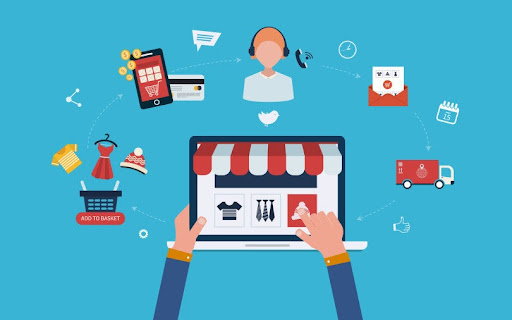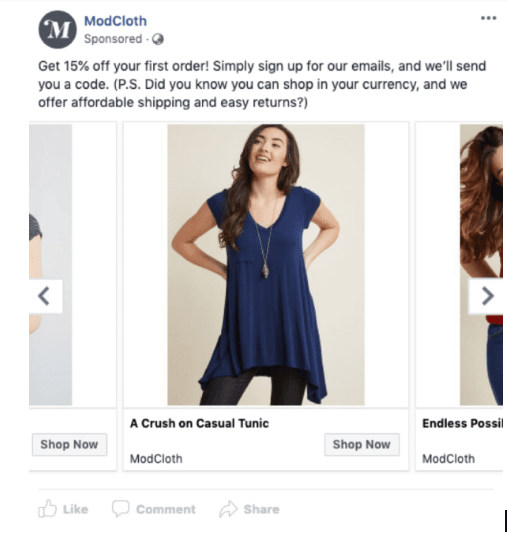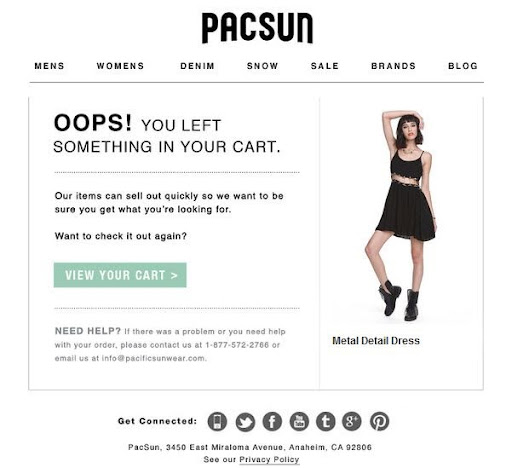By 2027, the eCommerce market is estimated to be worth USD 16,215.6 billion. With the rapid growth of digitalization globally, there is a significant increase in the number of eCommerce businesses in the market. Ecommerce has shown to be an excellent means of connecting with a global audience. Having an online store is a fantastic idea, but only if you have a marketing strategy to drive maximum traffic to your site and create brand awareness.
This blog will teach you about the greatest eCommerce marketing strategies, tips, and tools. But first, let’s familiarize you with the concept of eCommerce.
What is e-Commerce?
E-commerce usually referred to as electronic commerce, sells and purchases goods and services over the internet. All online shopping outlets, e-books, video courses, crowdfunding platforms, subscription-based enterprises, and so on are examples of e-commerce businesses. There are four different types of e-commerce business models between a customer and a seller.

The different types of e-commerce business models are as follows:
- B2C: It’s the business-to-consumer model, in which a company sells its products or services directly to customers. All the top e-commerce industries like Amazon, Walmart, and Alibaba use the B2C business model.
- B2B: In this strategy, a company sells its services or products directly to other companies. Businesses that want to offer their services in bulk commonly adopt this strategy. Examples of B2B are Datadog, MongoDB, ServiceNow, etc.
- C2C: A customer-to-customer business model is when a user sells their items to other consumers. Airbnb, Etsy, and Uber are examples of companies operating as C2C models. In addition, Amazon is an online retailer that uses both B2C and C2C business models.
- C2B: Consumer to business model works when a consumer adds some value to a business. Mostly the affiliation programs are referred to as C2B models. Examples are Commission junction, Google Adsense, etc.
With the growing number of online shopping stores, there is an ardent need for all e-commerce businesses to raise awareness of their online stores among potential customers if they want to stand out among their competitors. It can be achieved through the power of e-commerce marketing.
What is e-Commerce Marketing?
E-commerce marketing refers to the entire process of driving visitors to your site, converting those leads into permanent customers, and then providing incentives to keep your customers coming back to your store. It is a magic wand that uses the magical spell of e-commerce advertising on different channels and platforms, opening doors to new business opportunities.
Let us dive into the concept of e-commerce advertising before moving forward with the details about e-commerce marketing.
E-commerce Advertising
E-commerce advertising is how you promote your products and services and bring them in front of the public eye. Because it spans all digital platforms, this advertising will primarily take the shape of media ads, display ads, or banner ads to promote your brand across all platforms.

Marketers can ease their purchases online through social media, search engines, email campaigns, and digital content in e-commerce marketing and reap some incredible rewards for their business.
What are Some Exclusive Advantages of e-Commerce Marketing for Your Businesses?
Your company’s growth can be aided by using an online marketplace. It only requires the correct promotion to shine in the public eye and increase sales. The following are some of the advantages of e-commerce marketing.
- E-commerce marketing, when done correctly, provides maximum traffic to your e-commerce site while emphasizing it in front of your target buyers.
- It increases your online sales by converting leads into long-term consumers.
- Increases your website’s engagement rate, causing clients to remain longer and return to buy your products.
- Offer excellent deals to your clients to increase their happiness and customer satisfaction, which will lead to increased loyalty for your company.
- Your e-commerce business will always be looking for new methods to grow.
Now that you’re aware of the numerous advantages of e-commerce marketing, it’s time to familiarize yourself with the various marketing channels available for this strategy.
What are The Types of e-Commerce Marketing?
All the virtual marketing channels that work wonders with your e-commerce marketing strategies are as follows:
Social Media Marketing
Regardless of age or internet connectivity, 56.8% of the global population is engaged on social media. Everyone prefers to use social media platforms for marketing their brand, from well-established to growing firms. With 40% of internet users utilizing social media for business, it has shown to be an excellent medium for connecting with your target audience.
When choosing a social media platform for your e-commerce firm, you may need to be a little more particular. Social media marketing platforms can be divided into two categories.
- Organic Social Media Marketing
It is the unpaid advertisement of your e-commerce store on social networking sites such as Facebook, Instagram, and Pinterest. Because the majority of your target audience spends most of their time on these platforms, having a presence on them is incredibly important. You can tell them about your products and how important your services are in their lives. You may also use these platforms to develop an additional online channel for selling your goods and services. This option is for people who wish to buy your stuff directly. - Paid Social Media Marketing
Paid social media marketing includes all influencer marketing and ad campaigns on social media platforms like Facebook. When organic social exposure is lacking, you may need to pay to reach a larger audience. You can choose from a variety of ad formats to fit your requirements. Another option to reach out to an audience like mindful moms is influencer marketing, which involves paying well-known influencers to promote your product.
What Are The Best Strategies for e-Commerce Marketing?
E-commerce marketing strategies are how you can popularize your online store to drive more sales. The following strategies will help you attain the maximum benefit from this marketing strategy:
Define goals and objectives as per your industry standards
You can use certain benchmarks to define goals for your e-commerce business, depending on your business size, industry, and location. For example, compare your stores’ click-through rates, conversion rates, customer acquisition costs, and website visits to other businesses and set your goals accordingly.
Know your target audience
It’s very crucial to have a clear picture of your target audience. Make sure to know your prospect’s interests, purchasing power, and characteristics. Know your buyer persona and create a conversion funnel that works the best for your audience.
Evaluate your competitors
Keep an eye on your competition, evaluate their strategies, and look at which of their strategies will work best for your business to outrank them. Also, check what factors are causing turbulence in their business and what you can do differently to avoid the same issue in your business.
Personalized communication
By offering a personalized Ad, live chat, email, and SMS to your customers relevant to your business, you generate a sense of trust and loyalty. They can connect more with these messages than those generic messages that you send them.
Delight your customers
After a sale has been completed, it’s time to nurture and delight your customers with loyalty points that they can redeem later or a referral program that benefits them to continue to engage with your services even after the purchase.
7 Effective Tips That Will Assist You in eCommerce Marketing
Personalization
Consumers are more likely to shop on an eCommerce site that allows personalization, according to 45% of respondents. Personalization gives your customers a seamless purchasing experience and allows them to engage with your company. Personalization, according to 90% of marketers, increases revenue. Check your customer’s previous shopping history, demographics, and behavior, and then provide them with a customized product and shopping experience.
User-Generated Content
UGC, also known as customer-generated content, is developed and published by customers regarding your brand on social media and YouTube platforms. An unboxing video of your goods on TikTok or Instagram, a snap of your product on social media, or a behind-the-scenes film of your firm are all examples of UGC. It’s a genuine technique to get people’s attention who are truly interested in the product. As a result, there is a skyrocketing growth in your eCommerce store revenue generation with increased conversion.
For example, Starbucks’ popular #RedCupContest urges consumers to share interesting photos of their coffees on social media in exchange for a unique Starbucks gift card.

Increase Engagement on Instagram
500 million people are using Instagram daily worldwide. Increasing your followers and engagement on Instagram is an effective way to increase your eCommerce store sales. You must regularly share Instagram reels, stories about your items and provide a direct link for customers to purchase them.

Decrease Abandoned Shopping Carts
Your business loses money every time a consumer adds items to their shopping cart and then abandons them during the checkout process. By offering a discount or a free coupon, you can remind those customers to finish their transactions. The best approach is to send the above-mentioned abandoned shopping cart email.

Use a more refined approach, like Pacsun and other businesses do, by assuming the buyer forgot to complete the checkout process and including a call to action button encouraging them to complete the transaction.
Customer Testimonials
Customer testimonials are a compelling approach to promote the advantages of your product and services to the general public. These are the customized reviews you send to your prospects, focusing solely on the good aspects they mentioned.
Case Studies
Case studies allow you to highlight your clients’ accomplishments in a way that motivates potential customers to take action. Make sure to interview consumers who are in your target demographic. Using case studies, you can show your prospects how your product has affected people’s lives.
Create an Easy Website Design
Nobody wants to interact with a badly designed website that is difficult to navigate. To increase your eCommerce website’s retention rate, it must have an easy-to-use and responsive design. It must work on many devices, including laptops and mobile phones. People in this society are constantly on the move, so your website must be easily accessible from all locations for a high success rate.
List of eCommerce Tools That you Can Use for Your eCommerce Business
Take a look at the eCommerce tools that can pace up your marketing efforts.
Shopify
Shopify is one of the top eCommerce platforms available today. Its single interface and drag-and-drop feature make managing everything from orders to payments to deliveries a breeze. With the aid of this wonderful tool, you can construct your online store, which includes features such as Facebook ads, a POS system, and social commerce, among others.
Price: The starting plan of Shopify is $29/month, and the advanced plan goes upto $299/month.
Bigcommerce
It’s a powerful tool that can help your eCommerce business expand in various ways. With third-party plugins, an open SaaS platform enables flexible innovation. It has two categories of products: basics and enterprises. In addition, it allows you to connect to platforms such as Amazon, Instagram, Facebook, and eBay, among others.
Price: The most basic plan costs roughly $30 per month, and other price information is available upon request.
3DCart
3DCart is a powerful eCommerce platform that comes with over 200 built-in features and 50 free themes to help you build a high-converting online store. In addition, it’s an SEO-friendly web platform with full access to CSS and HTML for your store’s optimization.
Price: The basic plan starts from $19/month and goes upto around $229/month.
JungleScout
It is the ideal eCommerce tool for you to establish a business on Amazon. JungleScout enables you to start your business from the ground up. You can quickly customize your product list using high intent keyword research. In addition, it provides a simple user interface with built-in tools for tracking revenue, sales, and other business indicators.
Price: The basic plan is $49/month and can go upto $69/month.
Ultracart
Regardless of your previous expertise or the number of products in your catalog, you may use this eCommerce tool to create your online store. This tool contains several optimized themes that will assist you in creating a responsive website. In addition, you can establish numerous stores using the multi-language option.
Price: The basic plan starts from $49.95/month and goes upto $499.95/month
Examples of Few eCommerce Companies Achieving New Heights in Their Business
Ecommerce marketing offers new shopping opportunities to its customers, differentiating them from any other websites. Some highest-earning eCommerce companies are ruling this industry with their efforts. Some of them are mentioned below:
Amazon Inc.
Amazon is the world’s largest online store, shipping about 400 items per second. Since July 5, 1994, Amazon has evolved from an online bookstore to a global retail powerhouse. Their great success in this field is due to their personalized approach to meeting their clients needs and their seamless, user-friendly website.
Alibaba Group Holding Ltd.
Since its inception in 1999, Alibaba has become one of the highest-earning e-commerce retailers because of its smart business strategy. Their data-driven, tech-enabled models helped them shift market conditions and acquire a significant competitive advantage over competitors, extending their business to more than 200 nations.
eBay
eBay ended the year 2020 with the largest annual net revenue ever, $10,271 million. It was one of the first successful dot-com enterprises to define online purchasing. Its commercial success is due to its distinctive features, such as the buy it now option and online auction.
All in all,
You can get the most visitors to your website and turn them into long-term customers by using strategic and insightful eCommerce marketing. Customers who have a personalized purchasing experience are long-term and loyal. Platforms like social media (Instagram, Facebook) and Youtube may significantly enhance customer engagement and brand visibility, resulting in a significant increase in revenue generation for your company. In addition, several eCommerce tools, such as Shopify and Ecommerce, can assist you in building a successful online store and increasing sales.
Buck up and run your online business with effective eCommerce marketing strategies!
